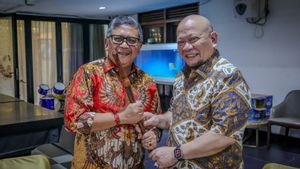JAKARTA – Facial recognition technology may already be used by the Iranian government to arrest and monitor anti-government activities. Even activists who oppose the imposition of dress laws on women based on religious beliefs.
Mahsa Alimardani, who researches freedom of expression in Iran from the University of Oxford, recently heard of reports of women in Iran receiving citations in the mail for violating hijab laws despite having never interacted with law enforcement officials.
“The Iranian government has spent years building digital surveillance tools,” Alimardani said, as quoted by The Wired.
The country's national identity database, built in 2015, includes biometric data such as facial scans and is used for national identity cards and to identify people deemed dissidents by authorities.
SEE ALSO:
Decades ago, Iranian law required women to remove the headscarf in line with modernization plans, and the police sometimes forced women to do so. But the headscarf became mandatory in 1979 when the country became a theocracy.
Iranian President Ebrahim Raisi imposed additional hijab and chastity restrictions last August. Women who are considered lawbreakers can lose access to banks, public transportation and other essential government services.
Repeat offenders can spend years in prison or in coercive morality schools. A database maintained by the non-profit organization United for Iran of more than 5.000 people imprisoned since 2011 shows that violations of the hijab rule often result in years in prison.
Cathryn Grothe, a research analyst at Freedom House, a US government-backed non-profit human rights organization, said she had seen a shift in Iran in recent years from a reliance on informants and physical patrols towards automated forms of digital surveillance to target people. critic.
Like Alimardani, he has received reports of people using online platforms to organize in Iran who suspect they are somehow recognized and then targeted by authorities offline.
"The Iranian government has been monitoring social media to identify opponents of the regime for years," Grothe said, but if the government's claims about the use of facial recognition are true, it is the first instance he is aware of of the government using the technology to enforce gender-related dress laws.
According to Grothe, facial recognition technology has become a desirable tool for authoritarian regimes around the world as a way to suppress dissent, despite the lack of the necessary technical infrastructure. "Iran is a case where they have the will of the government and the physical capabilities," Grothe said.
Parts of the Iranian government have access to facial recognition technology. Iranian traffic officers started using it in 2020 to issue fines and send warnings to women via SMS text about wearing the headscarf while in vehicles.
Mousa Ghazanfarabadi, head of the country's parliament's legal and judicial committee, spoke out last year in favor of "exemptions from social services and financial fines" for hijab offences.
"The use of facial recording cameras can systematically implement this task and reduce the presence of the police, so that there will be no more clashes between police and citizens," he told Iran's Enghelabe Eslami news agency.
Some of the facial recognition technology used in Iran today comes from Chinese cameras and artificial intelligence firm Tiandy. Its transactions in Iran are featured in a December 2021 report from IPVM, a company that tracks the surveillance and security industry.
According to report author Charles Rollet, Tiandy is one of the world's largest manufacturers of security cameras, but most of its sales are in China, and the company appears to be seizing the opportunity to expand into Iran.
IPVM found that Tiandy Iran's website at one time listed the Islamic Revolutionary Guard Corps, police, and government prison workers' organizations as their customers. Agent Rollet describes it as “the kind of place that raises red flags from a sanctions or human rights perspective.”
In December, the US Department of Commerce sanctioned Tiandy, citing its role in China's suppression of Uyghur Muslims and the provision of US-origin technology to Iran's Revolutionary Guards.
The company previously used components from Intel, but the US chip maker told NBC last month it had stopped working with the Chinese company. Tiandy himself did not respond to a request for comment from The Wired.
Exports from China have contributed to the recent rapid deployment of surveillance technology. When Steven Feldstein, a former US State Department surveillance expert, surveyed 179 countries between 2012 and 2020, he found that 77 of them were now using some form of AI-based surveillance. "Facial recognition is used in 61 countries, more than any other form of digital surveillance technology," he said.
In his recent book The Age of Digital Repression, Feldstein argues that authoritarian states have largely succeeded in counteracting the momentum of internet-backed protest movements. "They have adapted and used new tools to strengthen their power," Feldstein wrote.
Despite deploying repressive technology and mass surveillance, in the past month both China and Iran have witnessed some of the largest protests either country has seen in decades.
After someone dies, Shia Muslim custom calls for chehelom, a day to remember the dead 40 days after their death. The tradition is now sparking protests in Iran, as the more than 500 people killed since Masha Amini's death sparked a new wave of protests.
A cycle of chehelom after the killing of hundreds of people by government troops led to the Iranian people overthrowing the shah in 1979. Alimardani of Oxford hopes the current cycle of protests, which he calls the largest and most diverse since the revolution, will continue, with youth and women leading the way.
The English, Chinese, Japanese, Arabic, and French versions are automatically generated by the AI. So there may still be inaccuracies in translating, please always see Indonesian as our main language. (system supported by DigitalSiber.id)
















